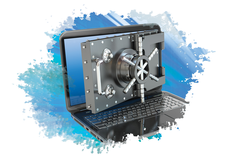Customizing the UEFI boot process
Smart Startup

The traditional BIOS dates back decades and has not been able to keep up with the rapid development of PCs and laptops. Its powerful successor UEFI takes over its tasks and provides more features, more convenience, and better security.
Since 1981, PCs have booted with the help of the Basic Input/Output System (BIOS). Over the years, different manufacturers have continued to expand the BIOS firmware system, but even after all this time, the BIOS system is difficult to adjust and still does not support 64-bit operation.
Back in the late 1992, Intel launched a new initiative to replace the venerable BIOS system with a 64-bit alternative. This Extensible Firmware Interface (EFI) initiative became the Unified EFI (UEFI) Forum in 2005. In addition to Intel, AMD, Microsoft, HP, and other prominent vendors contributed to the UEFI project.
UEFI describes the interface between a computer's firmware and operating system. Like BIOS, the UEFI implementation initializes the hardware components to prepare the launch of the operating system. However, UEFI natively supports 64-bit architectures, enables graphical user interfaces, and can protect against malicious software by only allowing signed operating systems (a feature that has come to be known as Secure Boot).
[...]
Buy this article as PDF
(incl. VAT)
Buy Linux Magazine
Subscribe to our Linux Newsletters
Find Linux and Open Source Jobs
Subscribe to our ADMIN Newsletters
Support Our Work
Linux Magazine content is made possible with support from readers like you. Please consider contributing when you’ve found an article to be beneficial.

News
-
Zorin OS 18 Hits over a Million Downloads
If you doubt Linux isn't gaining popularity, you only have to look at Zorin OS's download numbers.
-
TUXEDO Computers Scraps Snapdragon X1E-Based Laptop
Due to issues with a Snapdragon CPU, TUXEDO Computers has cancelled its plans to release a laptop based on this elite hardware.
-
Debian Unleashes Debian Libre Live
Debian Libre Live keeps your machine free of proprietary software.
-
Valve Announces Pending Release of Steam Machine
Shout it to the heavens: Steam Machine, powered by Linux, is set to arrive in 2026.
-
Happy Birthday, ADMIN Magazine!
ADMIN is celebrating its 15th anniversary with issue #90.
-
Another Linux Malware Discovered
Russian hackers use Hyper-V to hide malware within Linux virtual machines.
-
TUXEDO Computers Announces a New InfinityBook
TUXEDO Computers is at it again with a new InfinityBook that will meet your professional and gaming needs.
-
SUSE Dives into the Agentic AI Pool
SUSE becomes the first open source company to adopt agentic AI with SUSE Enterprise Linux 16.
-
Linux Now Runs Most Windows Games
The latest data shows that nearly 90 percent of Windows games can be played on Linux.
-
Fedora 43 Has Finally Landed
The Fedora Linux developers have announced their latest release, Fedora 43.

